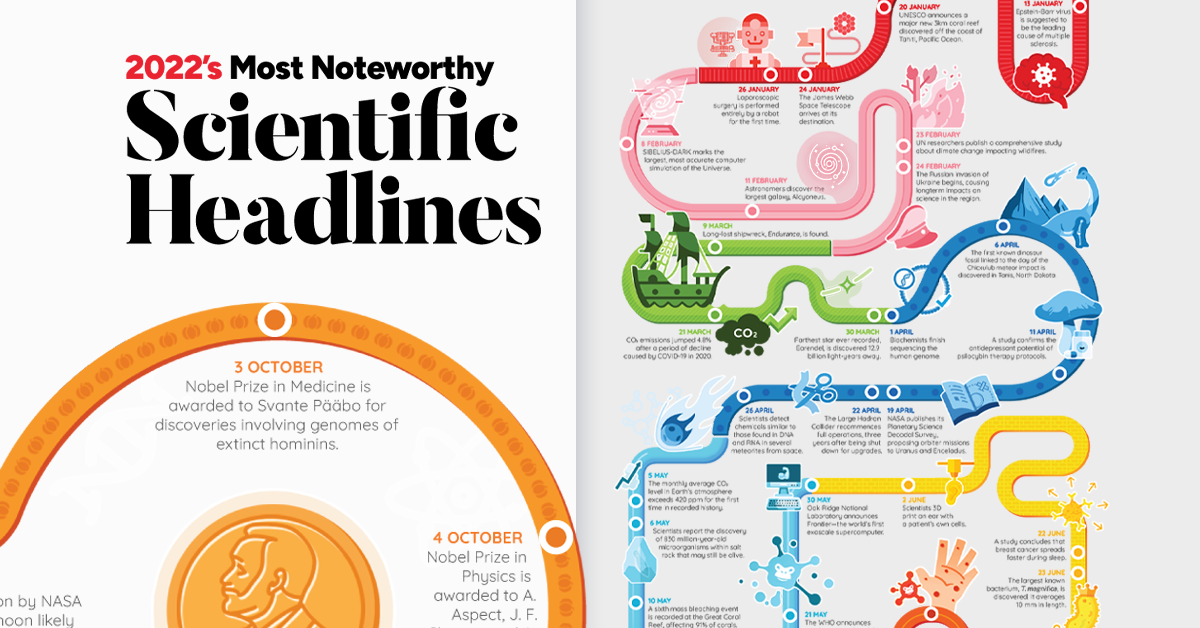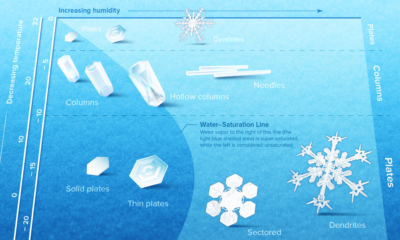Technology
Timeline: The Most Important Science Headlines of 2022

Scientific discoveries and technological innovation play a vital role in addressing many of the challenges and crises that we face every year.
The last year may have come and gone quickly, but scientists and researchers have worked painstakingly hard to advance our knowledge within a number of disciplines, industries, and projects around the world.
Over the course of 2022, it’s easy to lose track of all the amazing stories in science and technology.
At a Glance: Major Scientific Headlines of 2022
Below we dive a little deeper into some of the most interesting headlines, while providing links in case you want to explore these developments further.
The James Webb Space Telescope Arrives at its Destination
What happened: A new space telescope brings promise of exciting findings and beautiful images from the final frontier. This telescope builds on the legacy of its predecessor, the Hubble Space Telescope, which launched over 30 years ago.
Why it matters: The James Webb Space Telescope is our latest state-of-the-art “window” into deep space. With more access to the infrared spectrum, new images, measurements, and observations of outer space will become available.
» To learn more, read this article from The Planetary Society, or watch this video from the Wall Street Journal.
Complete: The Human Genome
What happened: Scientists finish sequencing the human genome.
Why it matters: A complete human genome allows researchers to better understand the genetic basis of human traits and diseases. New therapies and treatments are likely to arise from this development.
» To learn more, watch this video by Two Minute Papers, or read this article from NIH
Monkeypox Breaks Out
What happened: A higher volume of cases of the monkeypox virus was reported in non-endemic countries.
Why it matters: Trailing in the shadow of a global pandemic, researchers are keeping a closer eye on how diseases spread. The sudden spike of multinational incidences of monkeypox raises questions about disease evolution and prevention.
» To learn more, read this article by the New York Times.
A Perfectly Preserved Woolly Mammoth
What happened: Gold miners unearth a 35,000 year old, well-preserved baby woolly mammoth in the Yukon tundra.
Why it matters: The mammoth, named Nun cho ga by the Tr’ondëk Hwëch’in First Nation, is the most complete specimen discovered in North America to date. Each new discovery allows paleontologists to broaden our knowledge of biodiversity and how life changes over time.
» To learn more, read this article from Smithsonian Magazine
The Rise of AI Art
What happened: Access to new computer programs, such as DALL-E and Midjourney, give members of the general public the ability to create images from text-prompts.
Why it matters: Widespread access to generative AI tools fuels inspiration—and controversy. Concern for artist rights and copyright violations grow as these programs potentially threaten to diminish creative labor.
» To learn more, read this article by MyModernMet, or watch this video by Cleo Abram.
Dead Organs Get a Second Chance
What happened: Researchers create a perfusion system that can revitalize organs after cellular death. Using a special mixture of blood and nutrients, organs of a dead pig can be sustained after death—and in some cases, even promote cellular repair.
Why it matters: This discovery could potentially lead to a greater shelf-life and supply of organs for transplant.
» To learn more, read this article by Scientific American, or this article from the New York Times
DART Delivers A Cosmic Nudge
What happened: NASA crashes a spacecraft into an asteroid just to see how much it would move. Dimorphos, a moonlet orbiting a larger asteroid called Didymos 6.8 million miles (11 million km) from Earth, is struck by the DART (Double Asteroid Redirection Test) spacecraft. NASA estimates that as much as 22 million pounds (10 million kg) was ejected after the impact.
Why it matters: Earth is constantly at risk of being struck by stray asteroids. Developing reliable methods of deflecting near-Earth objects could save us from meeting the same fate as the dinosaurs.
» To learn more, watch this video by Real Engineering, or read this article from Space.com
Falling Sperm Counts
What happened: A scientific review suggests human sperm counts are decreasing—up to 62% over the past 50 years.
Why it matters: A lower sperm count makes it more difficult to conceive naturally. Concerns about global declining male health also arise because sperm count is a marker for overall health. Researchers look to extraneous stressors that may be affecting this trend, such as diet, environment, or other means.
» To learn more, check out this article from the Guardian.
Finding Ancient DNA
What happened: Two million-year-old DNA is found in Greenland.
Why it matters: DNA is a record of biodiversity. Apart from showing that a desolate Arctic landscape was once teeming with life, ancient DNA gives hints about our advancement to modern life and how biodiversity evolves over time.
» To learn more, read this article from National Geographic
Fusing Energy
What happened: The U.S. Department of Energy reports achieving net energy gain for the first time in the development of nuclear fusion.
Why it matters: Fusion is often seen as the Holy Grail of safe clean energy, and this latest milestone brings researchers one step closer to harnessing nuclear fusion to power the world.
» To learn more, view our infographic on fusion, or read this article from BBC
Science in the New Year
The future of scientific research looks bright. Researchers and scientists are continuing to push the boundaries of what we know and understand about the world around us.
For 2023, some disciplines are likely to continue to dominate headlines:
- Advancement in space continues with projects like the James Webb Space Telescope and SETI COSMIC’s hunt for life beyond Earth
- Climate action may become more demanding as recovery and prevention from extreme weather events continue into the new year
- Generative AI tools such as DALL-e and ChatGPT were opened to public use in 2022, and ignited widespread interest in the potential of artificial intelligence
- Even amidst the lingering shadow of COVID-19, new therapeutics should advance medicine into new territories
Where science is going remains to be seen, but this past year instills faith that 2023 will be filled with even more progress.
apps
How Long it Took for Popular Apps to Reach 100 Million Users
Threads reached 100 million users in just five days. Here is a timeline of how long other popular platforms took to reach the milestone.
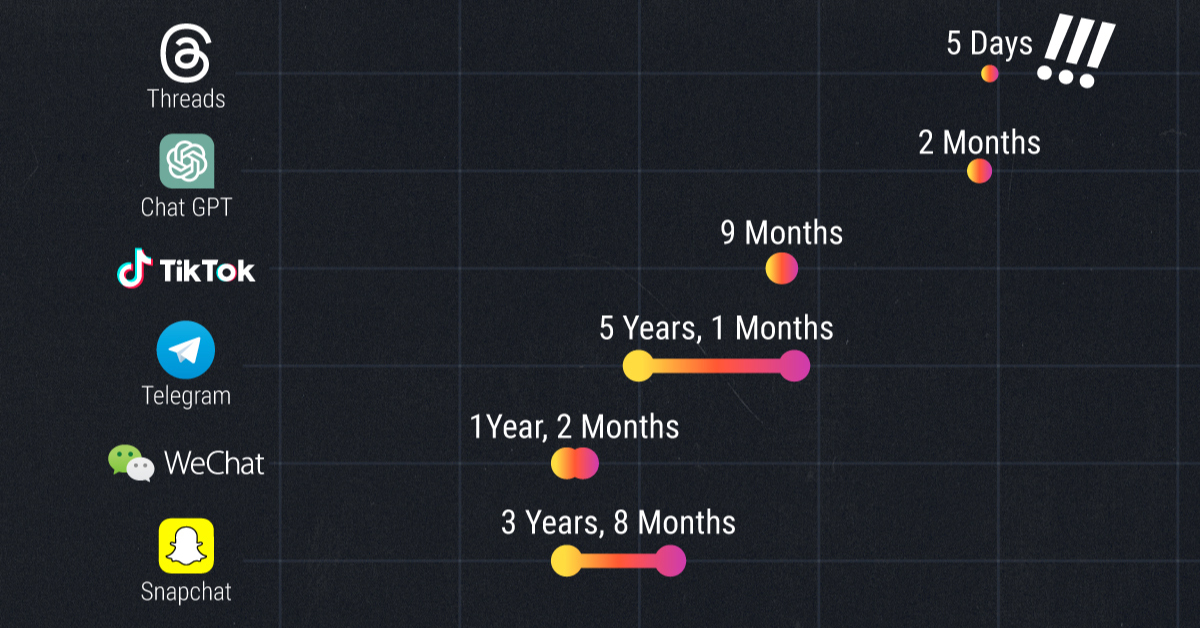
How Long it Took for Popular Apps to Reach 100 Million Users
Of Twitter’s many new rivals, Meta’s newest social media platform Threads has established its presence with a bang.
According to Meta founder Mark Zuckerberg, Threads took only 5 days to reach the key threshold of 100 million users. It achieved this milestone through organic demand—and no paid promotions required—smashing all previous records.
But how long have other popular platforms—TikTok, Instagram, and YouTube to name a few—taken to build their user base? Pulling data from PwC and Yahoo, we rank how long it took popular platforms to get to 100 million users.
Ranking Every Apps Journey to 100 Million Users
In first place, Threads has a significant lead over the rest of the pack with its five day achievement, and may have built a significant moat in holding on to this record.
Firstly, its launch coincided with Twitter’s viewing limit decision, and rode the wave of dissatisfaction aimed at Twitter’s current owner, Elon Musk.
Secondly, new users on Threads need an Instagram account to register, thus eliminating sign-up barriers and leveraging Instagram’s 1.2 billion-strong user base.
Here’s the journey length of popular platforms to attaining 100 million users:
| Rank | Platform | Launch | Time to 100M Users |
|---|---|---|---|
| 1 | Threads | 2023 | 5 days |
| 2 | ChatGPT | 2022 | 2 months |
| 3 | TikTok | 2017 | 9 months |
| 4 | 2011 | 1 year, 2 months | |
| 5 | 2010 | 2 years, 6 months | |
| 6 | Myspace | 2003 | 3 years |
| 7 | 2009 | 3 years, 6 months | |
| 8 | Snapchat | 2011 | 3 years, 8 months |
| 9 | YouTube | 2005 | 4 years, 1 month |
| 10 | 2004 | 4 years, 6 months | |
| 11 | Spotify | 2006 | 4 years, 7 months |
| 12 | Telegram | 2013 | 5 years, 1 month |
| 13 | 2006 | 5 years, 5 months | |
| 14 | Uber | 2011 | 5 years, 10 months |
| 15 | 2010 | 5 years, 11 months | |
| 16 | Google Translate | 2006 | 6 years, 6 months |
| 17 | World Wide Web | 1991 | 7 years |
| 18 | 2003 | 7 years, 11 months |
Ranked second, Open AI’s ChatGPT launched in November 2022 and hit 100 million users by the start of the new year. ChatGPT introduced the incredible capabilities of large language models to the masses, prompting a rush of sign-ups, and reviving old conversations around the potential consequences of AI.
Coming in at third place, ByteDance’s TikTok took just 9 months to reach 100 million users after its launch in 2017. Like Threads, TikTok benefited from another app, accessing popular lip syncing app Musical.ly’s existing user base after it was acquired and folded into TikTok.
WeChat and Instagram round out the top-five, also with interesting advantages. WeChat, an instant messaging platform similar to WhatsApp, benefited from its unique access to China’s notoriously closed internet market of 500 million users in 2012.
Meanwhile, Meta acquired Instagram when the photo-sharing platform had 30 million users, and more than tripled that number past 100 million in just one year.
And while Facebook ranks solidly middle-of-the-pack for fastest to 100 million users, it remains the platform with the most monthly active accounts, at nearly 3 billion. In fact, Meta’s lessons learned from Facebook have been well-leveraged, and the company owns 4 of the fastest apps to register 100 million users.
So What Does Threads Success Mean for Twitter?
Coming back to Threads’ incredible feat, however, it’s still early days whether an en-masse switch from Twitter is on the cards for Meta’s newest platform.
For one, Threads has faced significant criticism due to its intensive data collection practices and lack of accessibility features. It also is missing some key features from its rival, including trending topics, hashtags, and direct messages.
Meanwhile Elon Musk has been less than pleased with Threads’ success, deeming it a copy of Twitter and even threatening legal action.
Competition is fine, cheating is not
— Elon Musk (@elonmusk) July 6, 2023
So where does this leave the increasingly-crowded social media space? The next decade will set the stage for either more platform consolidation, or even further audience fragmentation.
-
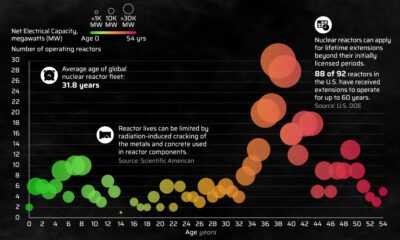
 Energy3 weeks ago
Energy3 weeks agoHow Old Are the World’s Nuclear Reactors?
-

 Countries7 days ago
Countries7 days agoMapped: World’s Top 40 Largest Military Budgets
-

 Energy3 weeks ago
Energy3 weeks agoHow Big is the Market for Crude Oil?
-
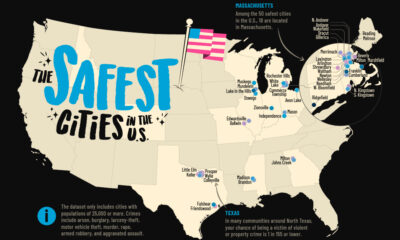
 United States6 days ago
United States6 days agoMapped: The Safest Cities in the U.S.
-
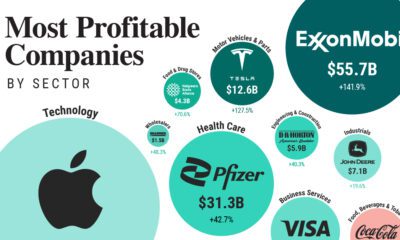
 Markets2 weeks ago
Markets2 weeks agoRanked: The Most Profitable U.S. Companies, by Sector
-

 apps5 days ago
apps5 days agoHow Long it Took for Popular Apps to Reach 100 Million Users
-

 Markets4 weeks ago
Markets4 weeks agoThe World’s Biggest Mutual Fund and ETF Providers
-

 Brands2 weeks ago
Brands2 weeks agoBrand Reputations: Ranking the Best and Worst in 2023




